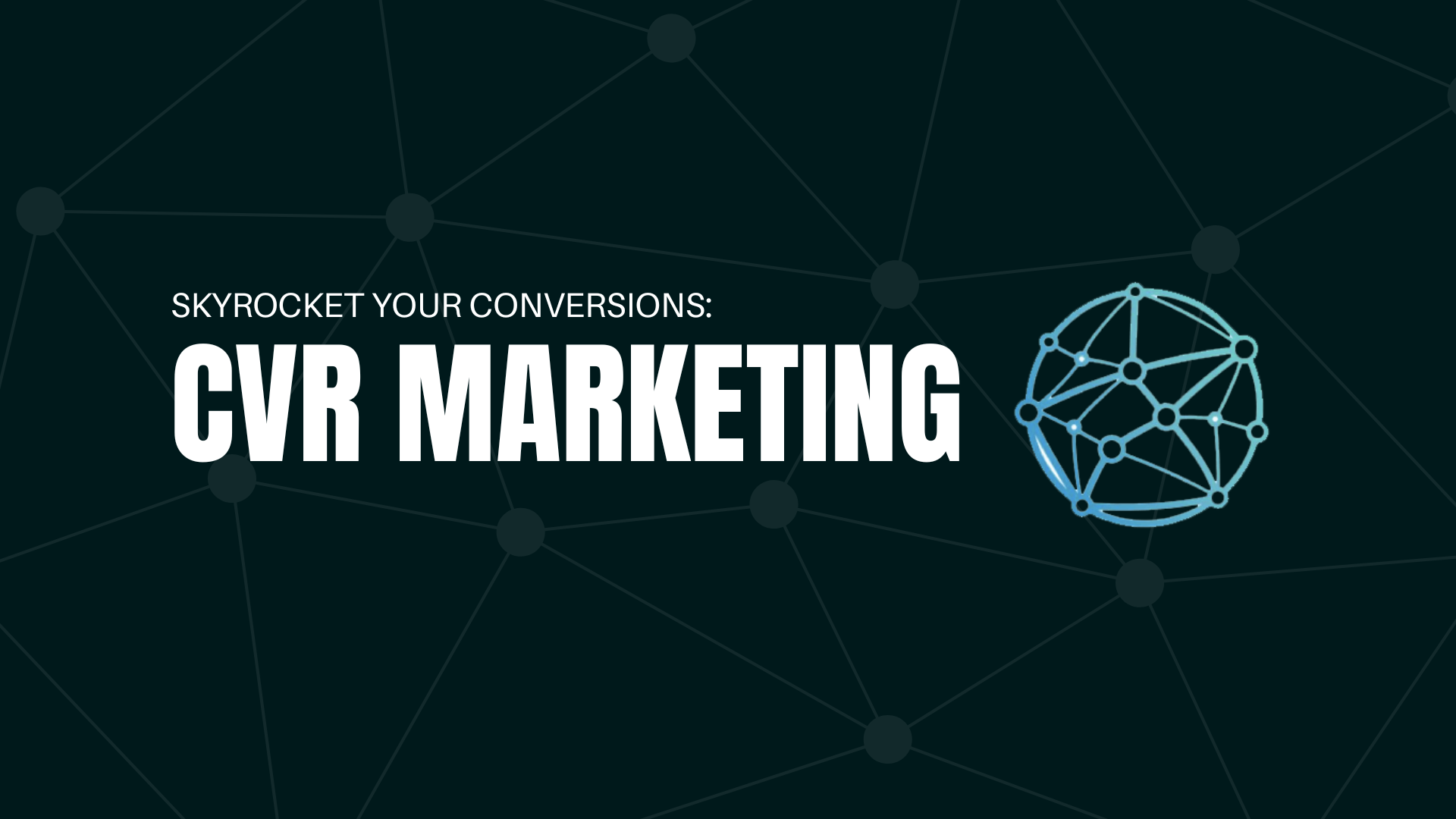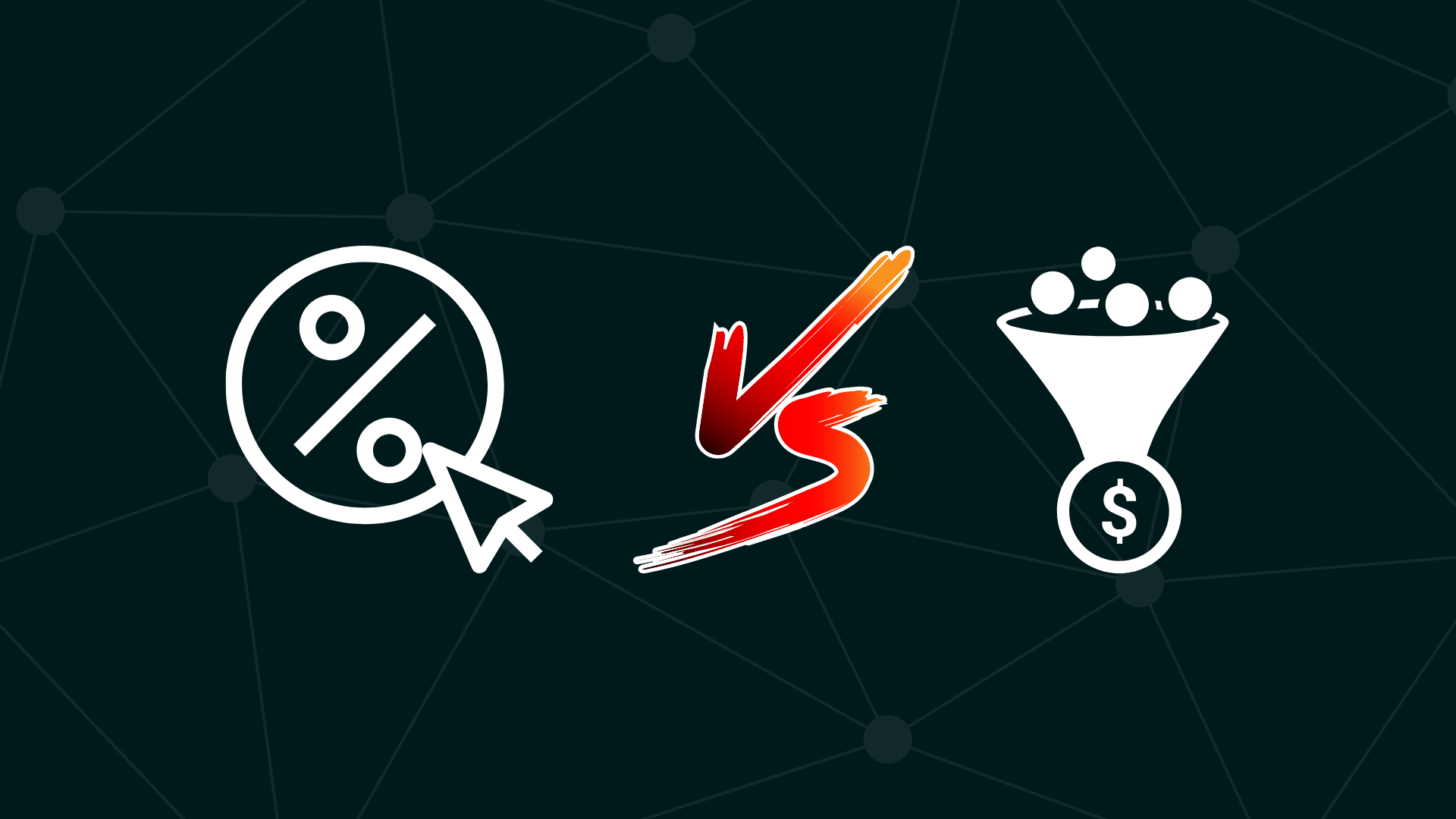We’ll increase conversions by
20-100+%
on your website.
Get a FREE Audit today
See how we can help your business increase conversion rates

Conversion Rate Optimization: How Marketing Improves CVR
It’s no secret that a strong online presence is essential for success in today’s business world. But simply having a website isn’t enough – you need to optimize it to drive conversions and boost your sales. That’s where CVR marketing comes in.
CVR marketing is the latest buzz in digital marketing, and for good reason. By fine-tuning your website and marketing strategies to increase your conversion rates, you can achieve impressive results and take your business to the next level.
But how can you tap into the power of CVR marketing? In this article, we’ll reveal everything you need to know. From expert insights to powerful tactics, you’ll learn how to transform your online presence and drive more sales than ever before. So get ready to discover the secrets of CVR marketing and take your business to new heights!
What is CVR?
CVR stands for Conversion Rate, which is the percentage of visitors to a website who complete a desired action, such as making a purchase, filling out a form, or subscribing to a newsletter. In the context of marketing, CVR is an essential metric used to measure the effectiveness of a marketing campaign or a website’s performance in generating revenue.
The higher the conversion rate, the better the website or marketing campaign is performing. Therefore, CVR is a critical metric for businesses that want to maximize their revenue and return on investment (ROI).
Why is CVR important?
CVR is essential for businesses because it directly impacts the company’s bottom line. Improving your conversion rates means more customers are taking the desired action, whether that’s making a purchase, subscribing to a service, or filling out a form. The higher the CVR, the more sales and revenue your business generates.
Moreover, CVR is a powerful metric to measure the success of a marketing campaign. It tells you whether your marketing efforts are driving the desired results, such as generating leads or sales. By tracking your CVR, you can determine which strategies are working and which ones need improvement.
In other words, CVR provides valuable insights that can help you optimize your CVR marketing efforts and improve your ROI.

Understanding common conversion rate metrics
Understanding different CVR conversion rates are essential for businesses that want to improve their revenue and optimize their CVR marketing efforts. There are several types of CVR conversion rates that businesses need to understand to improve their bottom line, including website CVR, landing page CVR, campaign CVR, and lead CVR. We also have a full guide to conversion rate optimization here.
From here on, we will explore each of these conversion rates in more detail and provide insights on how businesses can use them to drive more sales and revenue.
Website CVR
Website CVR, or website conversion rate, is the percentage of visitors to a website who complete a desired action, such as making a purchase, subscribing to a service, or filling out a form. Website CVR is a crucial metric for businesses because it directly impacts revenue generation.
To calculate website CVR, divide the number of website visitors who completed the desired action by the total number of website visitors and multiply by 100 to get the percentage. For example, if 1000 people visited your website, and 50 of them made a purchase, your website’s CVR would be 5%.
To improve your website CVR, you need to create a website that speaks directly to your target audience and addresses their pain points. This requires a deep understanding of your customers and their needs. Additionally, you should continually test and tweak your website design, content, and user experience to improve your number of conversions.
Some strategies that can help improve your website CVR include optimizing your landing pages, simplifying your checkout process, offering free shipping or discounts, and including customer testimonials and social proof.
By implementing CVR marketing strategies and continually monitoring your website CVR, you can generate more sales and revenue for your business.
Landing Page CVR
Landing page CVR, or landing page conversion rate, is the percentage of visitors to a specific landing page who complete a desired action, such as signing up for a service, downloading a resource, or making a purchase. Landing page CVR is a crucial metric for businesses that use landing pages to generate leads or sales.
To calculate landing page CVR, divide the number of people who completed the desired action on your landing page by the total number of visitors to the landing page and multiply by 100 to get the percentage. For example, if 100 people visited your landing page, and 20 of them filled out a form to download a resource, your landing page CVR would be 20%.
Moreover, you need to create a landing page that is specifically designed to convert visitors into customers or leads. This requires a clear and compelling value proposition, attention-grabbing headlines, persuasive copy, and a strong call to action.
You should also optimize your landing page design and user experience to ensure that visitors can easily navigate and find what they are looking for.
Some strategies that can help improve your landing page CVR include conducting A/B testing to compare different page designs and messaging, simplifying your form fields, including customer testimonials and social proof, and using multimedia elements such as images and videos to showcase your product or service.
Here are some best practices for landing pages that you might find useful.
Campaign CVR
Campaign CVR, or campaign conversion rate, is the percentage of people who completed a desired action, such as making a purchase or signing up for a service, as a result of a specific marketing campaign. Campaign CVR is a crucial metric for businesses because it allows them to measure the effectiveness of their CVR marketing efforts and allocate resources to the most successful ones.
To calculate campaign CVR, divide the number of people who completed the desired action as a result of the campaign by the total number of people who were exposed to the campaign and multiply by 100 to get the percentage. For example, if 10,000 people were exposed to your marketing campaign, and 500 of them made a purchase as a result, your campaign CVR would be 5%.
To improve your campaign CVR, you need to create campaigns that are designed to resonate with your target audience and address their pain points. This requires a deep understanding of your customer persona and the messaging and channels that are most likely to drive action. Additionally, you should continually test and tweak your campaigns to optimize performance and generate more sales and revenue.
Some strategies that can help improve your campaign CVR include using compelling visuals and messaging that capture attention and communicate value, targeting specific audience segments with personalized messaging, and optimizing your campaign across multiple channels such as social media, email, and search.
If you’re curious about how to find the best CVR formula for your business, then by all means, check this article out.

5 CVR Marketing strategies to improve conversion rates
Businesses of all sizes are utilizing various CVR marketing strategies to improve their online presence and attract potential customers. Among these strategies, search engine optimization (SEO), pay-per-click advertising (PPC), content marketing, email marketing, and social media marketing are some of the most popular and effective methods.
Each of these strategies aims to attract and engage a target audience and ultimately lead them to convert or take a desired action on the business’s website. With the right tools, quality digital content, and methods in optimizing these strategies for conversion rate, businesses can expect higher conversion rates in their online marketing efforts.
We will explore the different types of CVR marketing strategies and how your marketing team can effectively utilize them to increase their CVR.
Search Engine Optimization (SEO)
Search Engine Optimization, commonly known as SEO, is the practice of improving the quality and quantity of website traffic by increasing the visibility of a website or a web page in a search engine’s unpaid results. The primary goal of SEO is to ensure that a website appears as high as possible in the search engine results pages (SERPs) for specific keywords or phrases that are relevant to the business.
SEO involves a wide range of techniques, including optimizing the website’s content, ensuring that the website is mobile-friendly, improving the site’s loading speed, and building high-quality backlinks from other websites. These techniques help search engines better understand what a website is about and rank it higher in the search results, allowing web users to click on your page.
By improving a website’s SEO, businesses can bring in a high number of impressions, drive more traffic to their website and increase their chances of converting visitors into customers. The higher a website ranks in the search results, the more likely it is that a user will click on it and visit the site.
This increased traffic can lead to more conversions and ultimately, generate revenue for the business.
Pay-per-Click (PPC)
Pay-per-click (PPC) advertising is a digital marketing strategy that involves placing ads on search engine results pages or other websites and paying for each click on the ad.
Unlike SEO, which involves optimizing a website to rank higher in the organic search results, PPC allows businesses to bid on specific keywords or phrases and have their ads displayed at the top of the search results for those keywords.
PPC advertising is a cost-effective way to drive targeted traffic to a website, as businesses only pay when a user clicks on their ad. By targeting specific keywords and demographics, businesses can reach potential customers who are actively searching for products or services similar to theirs. This targeted traffic is more likely to convert into customers, as they have already expressed an interest in the product or service.
To be successful with PPC advertising, businesses need to create compelling ad copy or ad telling and target the right keywords and audience. They also need to continually monitor and adjust their ad campaigns to ensure they are getting the best return on investment.
Content Marketing
Content marketing is a digital marketing strategy that involves creating and sharing valuable content, such as blog posts, videos, infographics, or e-books, with the aim of attracting and engaging a specific target audience.
The idea behind content marketing is to create content that is useful, educational, or entertaining for your audience and that helps them solve a problem or meet a need.
Through valuable content, businesses can establish themselves as thought leaders in their industry, build trust with their audience, and drive traffic to their websites. Content marketing can also help businesses generate leads, as users who find the content users are more likely to subscribe to a newsletter or fill out a contact form.
To be successful with content marketing, businesses need to create high-quality content that is tailored to their target audience’s needs and interests. They also need to promote their content through various channels, such as social media, email marketing, ad creative, or guest posting, in order to reach a wider audience.
By optimizing their content marketing strategy for conversion rate, businesses can turn their website visitors into leads or customers. This can be achieved by including calls-to-action (CTAs) in the content, such as inviting users to sign up for a newsletter or offering a free trial of a product or service.
Moreover, businesses can also identify which types of content are most effective at driving conversions and adjust their strategy accordingly.
Social Media Marketing
Social media marketing is a digital marketing strategy that involves promoting products or services on social media platforms, such as Facebook, Instagram, Twitter, or LinkedIn.
The goal of social media marketing is to build a strong online presence and engage with your target audience in order to drive traffic to your website and increase conversions.
To be successful with social media marketing, businesses need to create a social media strategy that aligns with their overall CVR marketing goals and target audience.
This includes identifying the right social media platforms to focus on, creating engaging content, and developing a consistent brand voice and visual style.
One of the key benefits of social media marketing is that it allows businesses to build relationships with their audience through regular interaction and engagement. By responding to comments and messages, sharing user-generated content, and providing valuable information, businesses can establish themselves as trusted sources of information and build loyalty with their followers.
To optimize social media marketing for conversion rate, businesses can use various tactics, such as running targeted social media ads, including calls-to-action (CTAs) in their posts, and promoting exclusive offers or discounts to their social media followers.
Moreover, businesses can also identify which tactics are most effective at driving conversions and adjust their strategy accordingly.
Email Marketing
Email marketing is a digital marketing strategy that involves sending targeted messages to subscribers in order to promote products or services, build brand awareness, or nurture leads. The goal of email marketing is to build a relationship with your subscribers, provide them with valuable content and offers, and encourage them to take action, such as making a purchase or visiting your website.
To be successful with email marketing, businesses need to build a high-quality email list and segment it based on factors such as interests, purchase history, and demographics. This allows businesses to send targeted messages that are more likely to resonate with each subscriber and increase the likelihood of conversions.
One of the key benefits of email marketing is that it allows businesses to reach their audience directly in their inbox, where they are likely to be more receptive to marketing messages. By providing valuable content and offers in their emails, businesses can build trust with their subscribers and establish themselves as trusted sources of information.
To optimize email marketing for conversion rate, businesses can use various tactics, such as including clear and compelling calls-to-action (CTAs) in their emails, using A/B testing to identify the most effective subject lines and email designs, and segmenting their email list based on specific criteria.

Improve CVR with Digital Marketing Campaigns
Calculating CVR, or conversion rate is a straightforward process that involves dividing the number of people who completed a desired action by the total number of people who were exposed to the opportunity. To effectively calculate CVR, you need to have a clear understanding of the specific action you want people to take and the population you are targeting.
Here are the basic steps to calculate CVR:
Define the desired action
The first step in calculating CVR is to clearly define the action you want people to take. This could be making a purchase, filling out a form, signing up for a service, or any other action that aligns with your business goals.
Define the population
The second step is to define the population that you are targeting. This could be website visitors, landing page visitors, people who received a specific CVR marketing campaign, or any other relevant population.
Count the total number of people in the population
The third step is to count the total number of people in the population. This could be done by tracking website visitors using web analytics tools, or by counting the number of people who received a specific CVR marketing campaign.
Count the number of people who completed the desired action
The fourth step is to count the number of people who completed the desired action. This could be done by tracking purchases, form submissions, or other relevant actions using web analytics or other tracking tools.
Divide the number of people who completed the desired action by the total population
The final step is to divide the number of people who completed the desired action by the total number of people in the population and multiply by 100 to get the percentage CVR.
By effectively calculating CVR, you can track the performance of your marketing campaigns, landing pages, and website, and optimize your efforts to generate more leads and sales for your business.
Here are some top key metrics in ecommerce that you need to monitor in your next campaigns.
Marketing campaign elements to watch out
There are several factors that can affect the CVR (conversion rate) of a website or marketing campaign. Here are some of the most important ones:
Target audience
The people who are most likely to convert to your website or advertising campaign will depend on the product or service you offer, as well as the demographics, interests, and behaviors of your target audience.
Understanding your audience and tailoring your message and offers to their needs can help increase your CVR.
Offers
The offer you present to your audience can greatly impact your CVR. A strong, clear, and compelling offer that provides value to your audience can motivate them to take action.
You can also improve your lead generation efforts by simply incorporating scarcity marketing into your offers. You can do so by learning
Website design
The design and functionality of your website can also play a critical role in CVR. A website that is easy to navigate, visually appealing, and optimized for mobile devices can help to reduce bounce rates and increase engagement, which can lead to higher CVR.
Bringing in high-quality product images is also an underrated tactic, so better use them wisely!
Call-to-action (CTA)
The CTA is the instruction that prompts users to take the desired action, such as “buy now” or “sign up today.” A clear and prominent CTA that aligns with the user’s motivation can significantly increase CVR.
User experience
The overall user experience, including the loading speed of the website, the clarity of the content, and the ease of use of the checkout process, can have a significant impact on CVR.
Afterwards, ask and obtain their insights of their experience. That way, you may know their concerns and suggestions, as reviews are important.
Competition
The level of competition in your industry or market can affect your CVR. If there are many other businesses offering similar products or services, you may need to work harder to differentiate yourself and present a more compelling offer to your audience.
By taking these factors into consideration and continually testing and optimizing your website and marketing campaigns, you can improve your CVR and achieve your business goals.

What causes CVR to drop?
There are several factors that can cause CVR (conversion rate) to drop, including:
Changes in the target audience
If the characteristics, interests, or behaviors of your target audience change, it can lead to a drop in CVR. For example, if your product or service is no longer meeting the needs of your target audience, or if your audience has shifted to a new demographic or location, your CVR may suffer.
Poor website design or user experience
If your website is difficult to navigate, has slow loading times, or is not optimized for mobile devices, it can lead to a drop in CVR. A poor user experience can make it harder for users to find what they need and take the desired action, which can hurt your conversion rates.
Changes in offers on your ad campaign
If you change your offers or messaging without adequately testing the impact on CVR, it can lead to a drop in conversion rates. Changes to offers or messaging that are not aligned with the user’s motivation or expectations can be particularly damaging.
Increased competition
If there is an increase in competition in your industry or market, it can lead to a drop in CVR as users are presented with more options and become more discerning in their choices.
External factors
Changes in the external environment, such as economic or political instability, can also have an impact on CVR. For example, if people are experiencing financial hardship, they may be less likely to convert on offers that were previously successful.
To prevent a drop in CVR, it’s important to continually monitor and optimize your CVR marketing campaigns for your ecommerce store. Regularly testing and analyzing changes to offers, messaging, website design, and user experience can help you identify and address issues that may be impacting your conversion rates.
By staying ahead of changes in your target audience and the competitive landscape, you can maintain or even improve your CVR over time.

What is a Good CVR value?
A good CVR value depends on a variety of factors, including the industry, the specific action you want people to take, and the population you are targeting. Generally, a higher CVR is better, as it indicates that a greater percentage of people who were exposed to the opportunity completed the desired action.
However, what constitutes a “good” CVR can vary widely. For example, an e-commerce business might consider a CVR of 2% to be good, while a B2B company might aim for a CVR of 10%. It’s important to set realistic expectations based on your industry and specific goals, and continually strive to improve your CVR over time.
It’s also important to note that CVR is not the only metric that should be used to measure the success of a marketing campaign or website. Other factors such as traffic, engagement, and revenue should also be taken into consideration when evaluating performance.
In general, a good CVR value is one that is above the average for your industry and represents a significant improvement over your previous performance.

Is a higher CVR better?
In general, a higher CVR (conversion rate) is considered better because it indicates that a greater percentage of people who were exposed to the opportunity completed the desired action. For example, if your website has a CVR data of 5%, it means that 5% of the visitors to your website completed a specific action, such as making a purchase or filling out a form.
A higher CVR indicates that your website or marketing campaign is effectively converting visitors into customers, which can help to generate more leads and sales for your business. A high CVR is also an indication that your website or CVR marketing campaign is resonating with your target audience and providing them with the information and motivation they need to take the desired action.
That being said, what constitutes a “good” CVR can vary depending on a variety of factors, including your industry, the specific action you want people to take, and the population you are targeting. It’s important to set realistic expectations based on your industry and specific goals, and continually strive to improve your CVR over time.
It’s also worth noting that CVR is not the only metric that should be used to measure the success of a website or marketing ad campaign. Other factors such as traffic, engagement, and revenue should also be taken into consideration when evaluating performance.
Continually monitoring and optimizing your conversion ratio, along with other key performance indicators, can help you improve your overall return on investment and achieve your business goals.

CTR and CVR: How are they related?
Don’t worry, these technical terms don’t seem hard to understand once you get a gist of its principle.
CTR stands for click-through rate and CVR for conversion rate. These are two metrics that are commonly used to evaluate the performance of CVR marketing campaigns. While they are related in some ways, they measure different aspects of user behavior and should be evaluated independently.
Click-through rate measures the percentage of people who clicked on a link or ad compared to the total number of people who saw it. This important metric is calculated by dividing the number of clicks by the total impressions.
It is commonly used to measure the effectiveness of advertising or to evaluate the performance of a specific link or ad. A high CTR indicates that the ad or link is effectively attracting attention and driving traffic to a website or landing page.
CVR, on the other hand, measures the percentage of people who completed a desired action, such as making a purchase, app installs, or filling out a form, compared to the total number of people who were exposed to the opportunity. It is commonly used to measure the effectiveness of a website or landing page in converting visitors into customers.
While CTR and CVR are related, they are not the same thing. A high CTR does not necessarily mean that a website or landing page is effectively converting visitors into customers, and a high CVR does not necessarily mean that an ad or link is effectively driving traffic to a website or landing page. Instead, these metrics should be used together to gain a more complete understanding of the effectiveness of a digital marketing campaign.
For example, a high CTR might indicate that an ad is effectively driving traffic to a website, but a low CVR might indicate that the website is not effectively converting that traffic into customers.
By monitoring both metrics and making adjustments as needed, digital marketers can improve their overall campaign performance and generate more leads and sales for their business.
Conclusion
In a nutshell, by understanding the different types of CVR, calculating it effectively, and monitoring the factors that affect it, businesses can make informed decisions about their website and marketing strategies.
A higher CVR indicates that a larger percentage of website visitors are taking the desired action, such as making a purchase or filling out a form, which can lead to increased revenue and business growth. However, it’s important to note that a higher CVR isn’t always better and that other metrics, such as CTR, should also be taken into consideration.
At Convertica, we specialize in helping businesses improve their CVR through conversion rate optimization (CRO) strategies. By conducting in-depth analyses of website and marketing data, our team of experts can identify areas for improvement and implement targeted solutions that are tailored to each client’s unique needs.
If you’re looking to improve your CVR and increase your online sales, contact us at Convertica to learn more about how we can help.








